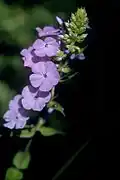Phlox maculata
| Phlox maculata | |
|---|---|
 | |
| Scientific classification | |
| Kingdom: | Plantae |
| Clade: | Tracheophytes |
| Clade: | Angiosperms |
| Clade: | Eudicots |
| Clade: | Asterids |
| Order: | Ericales |
| Family: | Polemoniaceae |
| Genus: | Phlox |
| Species: | P. maculata |
| Binomial name | |
| Phlox maculata L. | |
Phlox maculata, commonly called meadow phlox,[1] as well as wild sweet William[2] and marsh phlox,[3][a] is a species of flowering plant in the family Polemoniaceae, native the eastern United States and introduced to eastern Canada.[2] It is a perennial.[4]
Growing to 2–3 ft (61–91 cm), this erect, clump-forming herbaceous perennial produces clusters of fragrant, deep pink flowers in summer. The stiff stems are spotted red, hence the Latin specific epithet maculata. It prefers damp, well-drained soil in full sun. It is less prone to powdery mildew than the related Phlox paniculata.[5]
The following cultivars have received the Royal Horticultural Society's Award of Garden Merit:
-
.jpg)
-

-
 Botanical illustration
Botanical illustration -
_(7361660992).jpg) Botanical illustration
Botanical illustration
Notes
- ^ "Marsh phlox" also refers to P. glaberrima and P. kelseyi.
References
Wikimedia Commons has media related to Phlox maculata.
- ^ James H. Locklear. Phlox: A Natural History and Gardener's Guide. Timber Press, 2011. p. 169. ISBN 9780881929348
- ^ a b NRCS. "Phlox maculata". PLANTS Database. United States Department of Agriculture (USDA). Retrieved 13 November 2017.
- ^ Alan Branhagen. Native Plants of the Midwest: A Comprehensive Guide to the Best 500 Species for the Garden. Timber Press, 2016. p. 359. ISBN 9781604697773
- ^ "Phlox maculata". Native Plant Database. Lady Bird Johnson Wildflower Center, University of Texas at Austin.
- ^ "Phlox maculata". Missouri Botanical Garden. Retrieved 8 February 2021.
- ^ "Phlox maculata 'Alpha'". RHS. Retrieved 18 January 2021.
- ^ "Phlox maculata 'Natascha'". RHS. Retrieved 18 January 2021.
- ^ "Phlox maculata 'Omega'". RHS. Retrieved 18 January 2021.